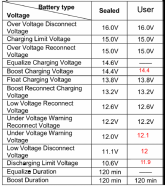My single port BMS can shut off the load yet still allow charge. As well ass shut off charge and allow load. I think it has reverse diodes when it has to open one direction or the other.
If the BMS is sending a signal to tell a charger to stop, that would be ok. If you are only charging to 80%, then I agree, CV absorption is not required. You can set to a little higher voltage to get there. But I have seen manuals for charge controllers that say to never have solar panels connected without a battery. If a BMS disconnected, that is what it would do. But I still do not see any advantage of having the BMS stop the charge over a charge controller doing it. If the cells are enough out of balance that the charge controller is stopping the charge because a single cell hit your target SOC voltage, then the rest of the cells are left short. If the charge controller held the pack at the desired SoC voltage, and let the balancer do it's job for a while, then all the cells would reach the target SoC.
I Agree with gnubie. A good charger or charge controller should be the brains behind the charging. If your charging system can't achieve the desired results, then you have a choice. You can try to band-aid it with BMS settings, or buy a better charger.



